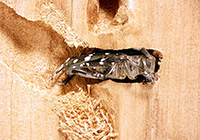Over the next 10 years, the number of cargo containers operating out of the Port of Savannah, Georgia, is expected to double. While additional cargo means increased revenue for the state, Chuck Bargeron, associate director of the University of Georgia Center for Invasive Species and Ecosystem Health, is concerned it could also lead to the establishment of more invasive species.
The center has identified more than 2,900 different species of wildlife, plants and insects that are present in, but not native to, North America. Many of those species come from Asia, where the ships that deliver cargo to the Port of Savannah originate.
“Doubling the number of ships that operate through this port is great for the health of the state’s economy, but in doing so, we can expect more invasive species to arrive as well. It’s inevitable,” Bargeron said.
According to the Georgia Ports Authority website, the ports of Savannah and Brunswick had a total tonnage of 30,832,880 in 2016, a growth of 16 percent over the previous five years.
The wood pallets on which the cargo is transported play host to most incoming invasive species. If the pallets are not properly heat-treated, then wood-boring pests, like the Asian longhorned beetle and the oak splendour beetle, could find a home in the pallet and relocate to North America in the process.
Invasive pests can better be contained if they are quickly identified before they spread, Bargeron said. The center has developed several apps for reporting invasive species. The Early Detection and Distribution Mapping System for Integrated Pest Management, called “EDDMapS IPM,” and regional reporting apps, like IveGot1, allow anyone to submit invasive species observations from the field. These reports are uploaded to a database and automatically emailed to local and state experts for review. The app captures the user’s precise location and allows the user to attach a picture of the species being reported.
Michael Toews, a UGA Cooperative Extension entomologist and center co-director, oversaw the development of EDDMapS IPM. The app, which is compatible with Apple and Google Android devices, allows scientists and farmers to track pests and make informed management decisions based on real-time conditions.
“These smartphone apps are critical tools for responding to invasive species in Georgia and throughout the country. Nearly everyone has access to a smartphone that can be utilized to upload a picture and information that enables specialists to quickly respond to this threat,” Toews said.
Toews was instrumental in researching the kudzu bug and assisting Georgia’s soybean farmers after the bug was identified in the U.S. in 2009.
“Shortly after its arrival, Georgia’s soybean crop became highly susceptible to the invasive kudzu bug. While the bug’s impact has diminished recently, it is definitely an example of how an invasive species can negatively impact Georgia’s crop production,” Toews said.
Bargeron attributes the impact of invasive species to the way they respond to their new surroundings.
“The way they behave here is different than the way they behave in their native environments. For example, think about Burmese pythons. It is estimated that there are more Burmese pythons in south Florida than in their native range in southern Asia. Burmese pythons are at the top of the food chain in the Everglades,” Bargeron said. “They were able to take over and really succeed. That’s something no one considered when they were letting people bring pythons in (to the U.S.) as pets.”
North American Invasive Species Forum
UGA recently hosted the North American Invasive Species Forum on May 9-11 in Savannah at the Coastal Georgia Botanical Garden at the Historic Bamboo Farm. The conference provided a forum for sharing knowledge about invasive species management across North America. Representatives from 26 states, Canada, Mexico and India attended the event.
Bargeron talked about the North American Invasive Species Network and management of invasive species within North America through collaboration and cooperation.
“Invasive species are nothing new, but what’s being done to manage them is always evolving. Forums like this allow us to discuss what management ideas are working in one location and how they might work in another,” he said.
The center’s list of invasive species can be found at www.invasive.org.
(Sharon Dowdy contributed to this story.)








